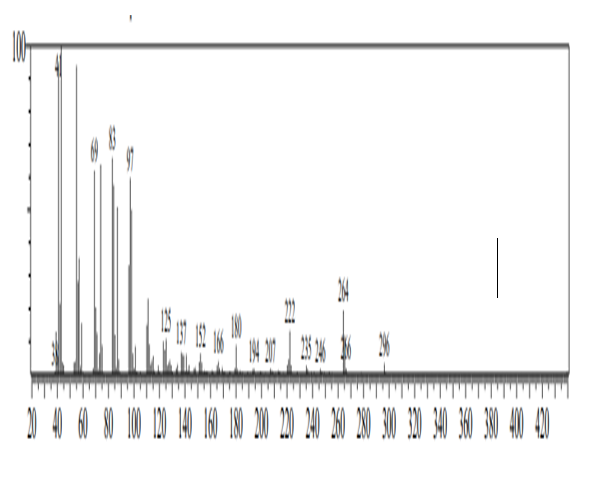Quantitative Phytochemical Analysis and Antioxidant Evaluation, Fractionation and Structural Elucidation of Oat Meal Extract
Main Article Content
Abstract
Avena sativa (Fam. Poaceae) popularly called oat is a cereal crop regarded as a functional food because it has medicinal uses in addition to its food ingredient like carbohydrates, proteins, lipids and fibres. It is reported to have anti-inflammatory, antimicrobial, antioxidant, anti-diabetic, anti-obesity, central nervous effect. The aim of this study is the quantitative phytochemical analysis, antioxidant evaluation, column chromatographic fractionation, TLC purification and isolation of fractions and GC-MS structural determination of isolated compounds. The aim of this study therefore is the bioassay guided extraction, fractionation purification to separate useful constituents and subsequent GC-MS structural elucidation of compounds present. The quantitative determination of the methanol extract was done using UV spectrophotometer for flavonoids, phenolics, alkaloids, tannins and saponins. The antioxidant activity was carried out using DPPH scavenging assay with vitamin E as standard. The Oat meal extract was subjected to column chromatography to separate it into its component fraction. The eluted fractions were further analyzed using TLC. GC-MS analysis of fraction was performed using a Perkin Elmer GC Clarus 800 system. The result shows that methanol extract of Oat meal is a rich source of flavonoids, phenolics, alkaloids, tannins and saponins (198.85, 60.51, 60.35, 20.30 and 60.15% respectively). Oat meal extract also show significant antioxidant activity (68%) which may be attributed to the synergistic effect of phytochemical content. Lipophilic extracts were mainly observed in the chromatographic separation and purification. The GC-MS analysis reviewed the presence of 15 bioactive compounds.
Metrics
Article Details

This work is licensed under a Creative Commons Attribution-NonCommercial 4.0 International License.
References
Surampudi V. What are phytochemicals? (And why should you eat more of them?). UCLA Health. Cited December 2024. Retrieved from https://www.uclahealth.org/news/article/what-are-phytochemicals-and-why-should-you-eat-more-them/. Retrieved on 23rd November, 2024
Kumar APN, Kumar M, Jose A, Tomer V, Oz E, Proestos C, Zeng M, Elobeid TKS, Oz F. Major Phytochemicals: Recent Advances in Health Benefits and Extraction Method. Mols, 2023; 28(2):887.
Chow YY, Ting ASY. Influence of fungal infection on plant tissues: FTIR detects compositional changes to plant cell walls. Fungal Ecol. 2019; 37: 38–47.
Okafor CE, Ijoma IK, Igboamalu CA, Ezebalu CE, Eze CF, Osita-Chikeze JC, Uzor CE, Ekwuekwe AL. Secondary metabolites, spectra characterization, and antioxidant correlation analysis of the polar and nonpolar extracts of Bryophyllum pinnatum (Lam) Oken. BioTechnologia (Pozn). 2024; 105(2):121-136.
Ijoma IK, Ajiwe EIV, Odinma CS. The organic extracts from the leaves of Ficus thonningii Blume, Jatropha tanjorensis J.L Ellis and Saroja and Justicia carnea Lindley as potential nutraceutical antioxidants and functional foods. Trends Phyto Res, 2023; 7(1): 76.85.
Nakai K, Tsuruta D. What Are Reactive Oxygen Species, Free Radicals, and Oxidative Stress in Skin Diseases? Int J Mol Sci., 2021; 22(19):10799.
Onyeloni SO, Etoh AP. Qualitative phytochemical screening, micronutrients and heavy metal evaluation of Oat meal (Avena sativa). Int J Bio, 2023; 22(4): 103-107.
Dhivya R. Manimegalai K. Phytochemical Screening and analysis of active secondary metabolites present in the ethanolic extract of Calotropis gigantea leave using GC-MS technique. World J. Pharm Pharma Sci. 2016; 5(10): 1510-1523.
Rajkumar P, Sundari S, Selvaraj S, Natarajan A, Suganya R, Jayaprakash R, Kasthuri K, Kumaresan S. GC-MS, Phytochemical Analysis and In Silico Approaches of a Medicinal Plant Acalypha indica. J Sci Res, 2022; 14(2): 671-684.
Madhu M, Sailaja V, Satyadev T, Satyanarayana MV. Quantitative phytochemical analysis of selected medicinal plant species by using various organic solvents. J Pharm Phyto, 2016; 5(2):25-29.
Baliyan S, Mukherjee R, Priyadarshini A, Vibhuti A, Gupta A, Pandey RP, Chang CM. Determination of Antioxidants by DPPH Radical Scavenging Activity and Quantitative Phytochemical Analysis of Ficus religiosa. Molecules, 2022; 27(4):1326.
Gomathi D, Kalaiselvi M, Ravikumar G, Devaki K, Uma C. GC-MS analysis of bioactive compounds from the whole plant ethanolic extract of Evolvulus alsinoides (L.) L. J Food Sci Technol, 2015; 52(2):1212-7.
Zhang Y, Cai P, Cheng G, Zhang Y. A Brief Review of Phenolic Compounds Identified from Plants: Their Extraction, Analysis, and Biological Activity. Natural Product Communications, 2022; 17(1).
Nithya M, Ragavendran C, Natarajan D. Antibacterial and free radical scavenging activity of a medicinal plant Solanum xanthocarpum. Inter J F Propert, 2018; 21(1): 313–327.


